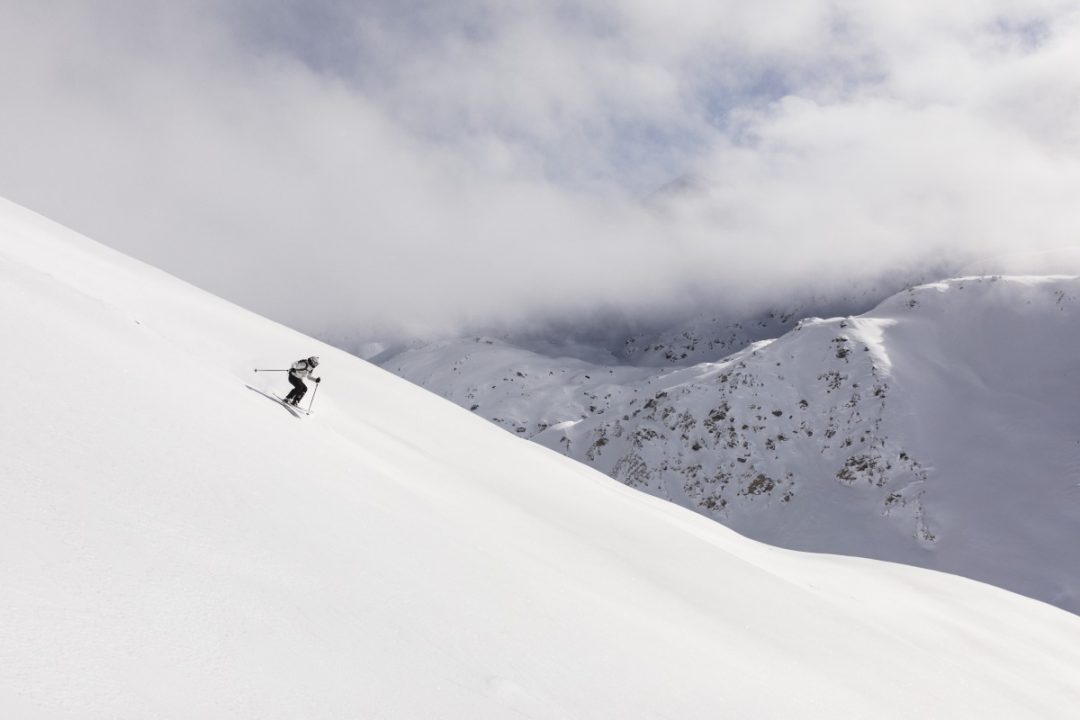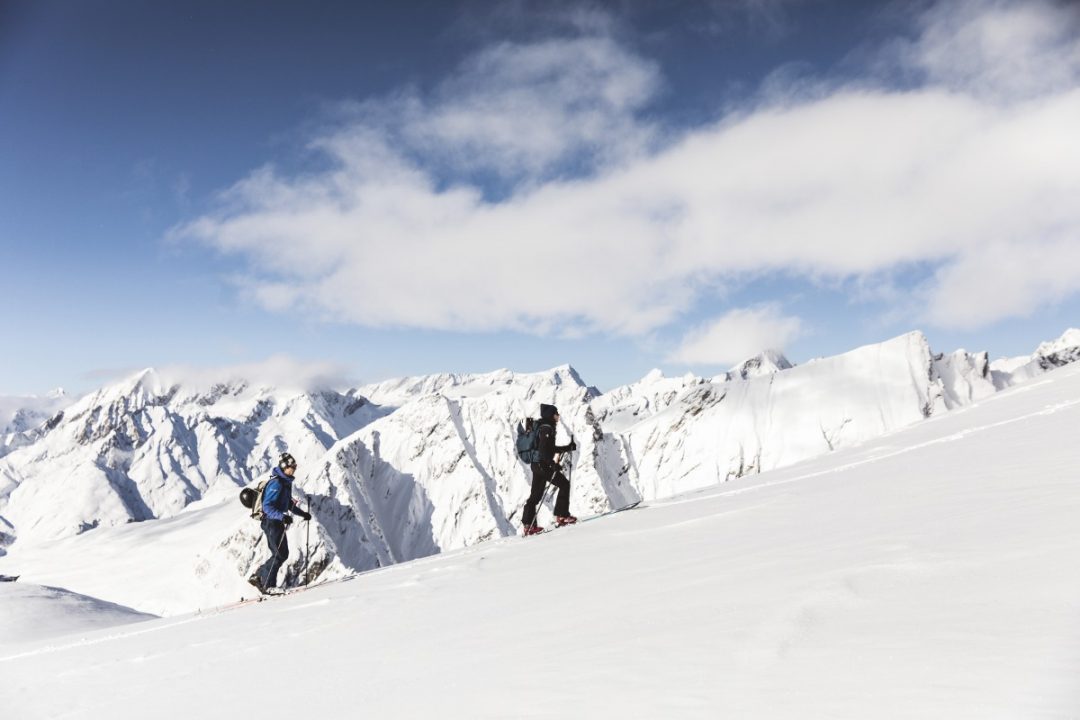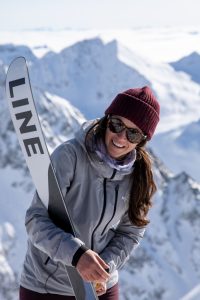
Key questions to ask ourselves: how can mentorship create long-term learning? How can backcountry users engage in micro-mentorships to create a safer community? Photo: Ramona Waldner/@ramonawaldner.
We watched six men leave the Aiguille du Midi cable station, stumbling down the arète that would lead them to the glaciated ski descent of the famed Vallée Blanche above Chamonix. The blank soles of their rental boots challenging their tedious position, empty spaces of air swirling around their left and right. No harnesses, no crampons, no guide, and no clue to the risk they were exposing themselves to.
The usual mocking came from members of our group. “Idiots.” With raised eyebrows, the other half of our group look concerned, knowing one exaggerated slip leads to an unsurvivable fall.
There could be countless factors that separated them from us, an equipped and knowledgeable party. The unaware tourists seemed to have a leader, and maybe this was our greatest distinction. They were mentor-less.
I was born in the mountains to parents who recreated in the mountains but did so under the tutelage of guides and packers of the Sierras and Tetons. Education was always a part of my childhood mountain experiences. My social circles include savvy mountain travelers from whom I learned how to do things right, and how to recognize when I was doing things wrong. In the case of the party passing us along the arete, their group leader may have had the right intentions, but certainly was not the guide or mentor they needed.
In every arena—be it in the mountains or the cities, there is a learning curve inherent to being in a new environment. In business, new jobs usually start with weeks of training. In the mountains, training isn’t necessarily inherent or facilitated by more knowledgeable others. The case of an unaware backcountry traveler is certainly not unique to the men we saw on the arete. There has been a boom in backcountry education, but those weekends are fleeting for beginners and advanced participants, so how can mentorship create long-term learning? How can backcountry users engage in micro-mentorships to create a safer community?
In the 1980s, Sony adopted a corporate-wide practice where new employees were marked by a green circle on their id badges. “The green circle tells experienced employees to stop and give their full attention to the new employee, to share know-how and the ways of the corporate culture. Akio Morita, the now deceased chairman of Sony, had a clear vision of the role this philosophy played in Sony’s success: ‘we are making ourselves responsible for their education and well-being. I consider it my job as a manager to do everything I can to nurture the curiosity of people I work with.’” (Beyond the Myths and Magic of Mentoring Margo Murray pg 10/11).
Backcountry users wearing a green circle would not be necessary-it’s often not difficult to spot backcountry novices and intermediates: but what if the backcountry community focused on the latter half of the Sony practice, taking an invested interest in community-wide education and opportunities for micro mentorship? Instead of thinking not only about individual backcountry safety, what if we included the health and survival of the community of users as a whole? Not only because the terrain you choose can expose you to the consequences of others’ choices, but also to lessen the weariness one experiences in mountain towns when you end up attending more funerals than weddings.

In every arena-be it in the mountains or the cities, there is a learning curve inherent to being in a new environment. Photo: Ramona Waldner/ @ramonawaldner.
Mentorship in the outdoors seems to exist in climbing, but less so in skiing. So I began my investigation in the alpine world. Rolando Garibotti, alpinist and author, has been known to mentor countless climbers in the El Chalten region of Patagonia where he dwells in the winter. “Becoming an adviser was not intentional,” Garibotti explained. “Over time, as a result of being interested and investing myself in certain topics, I came to have know-how and information that was also useful to others. Passing it on was only natural. This included route information, weather forecasting, gear, tactics, etc.”
In a sport like skiing where good conditions are scarce, passing along information, or “beta,” can be a hard sell: powder, for example, is treated like a rare earth element, where “it’s mine, not yours.” The scarcity mindset rules. Conditions reports are often and understandably kept within groups. Such head-down hunts for ski objectives can be toxic. But if grounded mentorship leads to behavioral changes, where the greater user population is making more educated decisions around everything from route choice to snowpack observations to mountain courtesy, this seems like a net gain for the backcountry community where the toll of accidents has a rippling effect on the health of that community.
“Starting around 2004, the house we shared in El Chalten with Bean Bowers had an open door policy,” said Garibotti. “Before every good weather window, sometimes dozens of people would swing by, and even after compiling much of that knowledge in a website and later in a book, they still do. Not sharing never felt like an option. The information was not mine to keep.”

“Most people understand the need to be cautiously progressive in their evolution, while others are eager to skip steps. Helping people ask the right questions seems like a good strategy to allow people to discover for themselves the limitations and blind spots of a plan,” -Rolando Garibotti. Photo: Ramona Waldner/ @ramonawaldner.
Images of a small cabin at the entrance of the national park or in the village of Jackson Hole, where knowledge is shared between generations feels like an ideal dream—a fleeting dream perhaps with real estate prices preventing this sort of house to exist. On top of that, organic mentorships are hard to find for experienced and novice riders alike. Maybe this is because our lives revolve more around digital connection, or because there is a weight that comes to being a mentor, particularly when you’re advising someone on a risk-inherent activity.
“Most people understand the need to be cautiously progressive in their evolution, while others are eager to skip steps. Helping people ask the right questions seems like a good strategy to allow people to discover for themselves the limitations and blind spots of a plan”, Garibotti notes. “When someone walks through my door I try to be aware of the importance that certain experiences can have in one’s life. Balancing that with the fear of egging someone too far forward is a juggling act that has no roadmap. I try my best to affirm when warranted, and to help refocus when I feel there might be too much at stake, but doing so without letting my cultural and generational biases get in the way of the creativity of youth. It is a very imperfect act. Certainly, the vanguard should not be bound by my constraints”.
When first approached to write a piece about backcountry mentorship, my first thought was I don’t have any mentors and I don’t know where to find them. I should note I have access to a lot of education through my family, boyfriends, friends, and colleagues. I have had plenty of micro-mentoring moments from my peers. But mentorship, the kind in which someone unrelated to you invests in your personal growth in the mountains, remains as elusive for me as a crowd-free powder day in Jackson Hole. This is where facilitated mentorship can break down the barriers to counsel.
Recently, there has been a huge uptick in backcountry riding education. From avalanche classes to first-aid, to route planning and packing classes, you’d be hard-pressed to find a mountain town without access to public education for skiing and riding. In these classes, there’s an opportunity to find great teachers, but with extra effort, you can find a mentor too. When finding a mentor feels too elusive, or when your parents, romantic partners, or coworkers don’t have the knowledge, professional ski mountaineer Christina Lustenburger recommends signing up for an avalanche course. In her guiding courses, she befriended Lars Andrews who has remained her mentor ever since. “Find an instructor or guide that moves through the mountains in a way you’d like to emulate and message them expressing your desire to learn more,” Lustenberger advises. Mentoring is a two-way relationship, and it’s usually up to the mentee to spark the relationship.
For athletes looking to have a career-focused mentor, brands such as Scarpa and The North Face have initiated their own mentorship programs pairing established athletes with accomplished athletes from historically marginalized communities. Many brands are looking to do the same in the future.
In between drafts of writing about mentorship, I reached out to two figures in the backcountry I admire, whom I hope will guide me along my path: An intimidating and awkward process even as an established skier, that I hope you, reader, will join me in doing.
At the end of our day skiing the Vallée Blanche, we saw the beginner group at the bottom of the valley waiting to take the train back to Chamonix. While I was certainly relieved, I was also a bit disappointed in myself for not offering some guidance. Because as Rolo says, how to ski in the backcountry is not my knowledge to keep. Skiing perfect backcountry powder adds value to my own life, but sharing the how-tos is the only way I can spread that value exponentially. I should remember that while I’m looking for a mentor for my high altitude skiing, I have the ability to mentor someone, both at a macro or micro level, who is looking to ski in the backcountry. If there can be a pinnacle of human relationship—an unrelated stranger believing in you might be at the top. By finding opportunities to receive and give micro-mentorship as a way to elevate all backcountry users, we could reduce accidents and fatalities even while the population of backcountry users increases.
From growing up at the base of the Tetons in Jackson Hole, Wyoming to becoming a professional skier traveling the globe for big mountain expeditions and competitions, Hadley prefers to explore with skis on her feet. Since she debuted in the Freeride World Tour at age 25-‘old’ for most competitors, she’s gone on to star regularly in ski films-descending mountain faces, all the while representing companies including The North Face on their global athlete team. While her sommelier degree, love for literature, and soft-spoken nature don’t quite match the industry stereotype, Hadley has proved capable of carrying the paradox of grit and grace to the steep faces of the mountains-embracing the duality as she ascends and descends. The 35-year old lives in the Alps and Tetons. Hammer expresses herself on mountains and translates the thoughts behind those experiences onto paper.

Hadley Hammer lives outside Chamonix where she penned these words. Photo: Nodum Sports/ Zlu Haller
From growing up at the base of the Tetons in Jackson Hole, Wyoming to becoming a professional skier travelling the globe for big mountain expeditions and competitions, Hadley prefers to explore with skis on her feet. Since she debuted in the Freeride World Tour at age 25-‘old’ for most competitors, she’s gone on to star regularly in ski films-descending mountain faces, all the while representing companies including The North Face on their global athlete team. While her sommelier degree, love for literature, and soft spoken nature don’t quite match the industry stereotype, Hadley has proved capable of carrying the paradox of grit and grace to the steep faces of the mountains-embracing the duality as she ascends and descends. The 35-year old lives in the Alps and Tetons. Hammer expresses herself on mountains and translates the thoughts behind those experiences onto paper.
